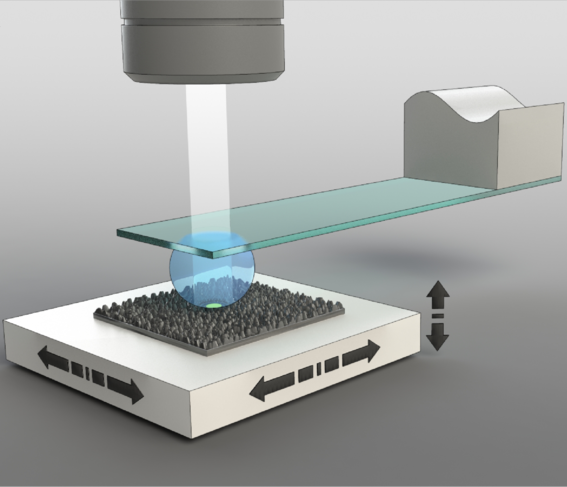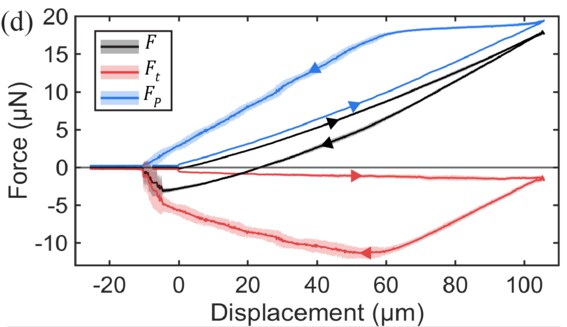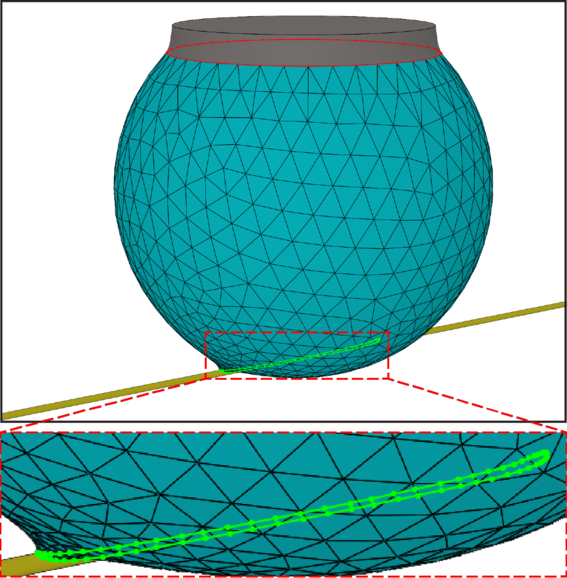Characterizing wetting with transparent probe

Contact angle measurement is a primary characteristic method for surface wettability. However, current contact angle measurement instruments suffer from great inaccuracy where the error can be close to 10˚ when the contact angle of the surface is large, i.e., for a highly phobic or superphobic surface.
In this research, we have developed a special robotic instrument - a transparent droplet probe - that can directly observe the evolution of the wetting contact line and quantify the contact angle precisely. The probe is composed of a transparent glass cantilever with a droplet probe attached to its end. By precisely controlling the volume and location of the droplet probe and using a normal optical microscope, we can quantify the progression of the apparent contact area and apparent contact line irregularity in different types of superhydrophobic silicon nanograss surfaces. Contact angles near 180˚ can be determined with an uncertainty as low as 0.2˚, which a conventional contact angle goniometer cannot distinguish. We also identify the pinning/depinning sequences of a pillared model surface with excellent repeatability and quantify the progression of the apparent contact interface and contact angle of natural plant leaves with irregular surface topography.


Using the cantilever as the force sensor, the transparent droplet probe can also work in a multimodal that allows simultaneous visualization of the wetting interface and measurement of interaction forces. During the interaction with the sample, the wetting interface is directly imaged through the probe, illuminated with coaxial lighting. The interaction force is simultaneously measured as the deflection of the cantilever-shaped probe. By combining top view, side view, and high-resolution force sensing, the probe can reveal force contributions from both surface tension and Laplace pressure and measure super-repellent surfaces with contact angles near 180˚ with a low experimental uncertainty of 0.5˚.

Characterizing the wetting properties of fibers is crucial for many research and industry applications, including textiles for water-oil separation and composite materials. Those fibers are often soft, typically tens of micrometers in diameter but millimeters in length, making manipulation and characterization difficult. Contact angles of single fibers are usually determined by droplet shape analysis or force-based Wilhelmy method. However, these methods are unable to accurately measure contact angles above 60 ° or ensure reliable control of the liquid-fiber interaction process, especially for soft fibers prone to bending.
We use the transparent droplet probe to measure the advancing and receding contact angles of both soft and rigid single fibers. By analyzing side-view images, we extract key geometrical parameters of the disk-droplet-fiber system, which, when used in detailed simulations, allows for estimating the contact angle of fibers ranging from 20 ° to 140 °.
Selected publications:
- Vieira, A., Cui, W., Jokinen, V., Ras, R.H. and Zhou, Q., "Through-drop imaging of moving contact lines and contact areas on opaque water-repellent surfaces", Soft Matter, 19(13), pp.2350-2359, 2023.
- Vieira, A. and Zhou, Q., "Multimodal Sensing Transparent Droplet Probe for Characterization of Superhydrophobic Surfaces", IEEE Sensors Journal, 23(15), pp. 17462 - 17469, 2023.
- Vieira, A., Jokinen, V., Lepikko, S., Ras, R.H. and Zhou, Q., "Through-Drop Imaging of Liquid–Solid Interfaces: From Contact Angle Variations Along the Droplet Perimeter to Mapping of Contact Angles Across a Surface", Langmuir, 40(17), pp.9059-9067, 2024.
- Vieira, A., Vuckovac, M., Schlapp-Hackl, I., Hummel, M., Zhou, Q. "Droplet probe for characterization of advancing and receding contact angles of single fibers", Proceedings of 2023 International Conference on Manipulation, Automation and Robotics at Small Scales, MARSS 2023, Abu Dhabi, Oct. 9-13, 2023. (Best Conference Paper)






